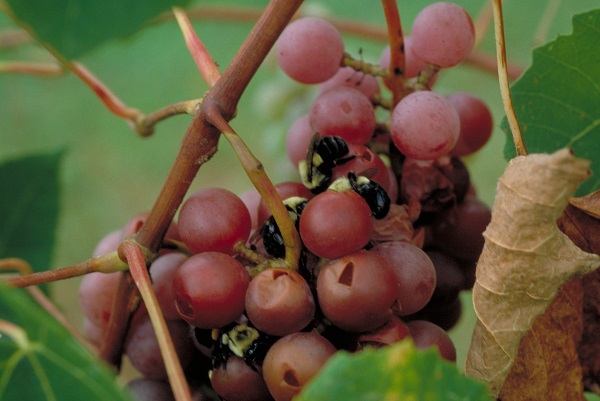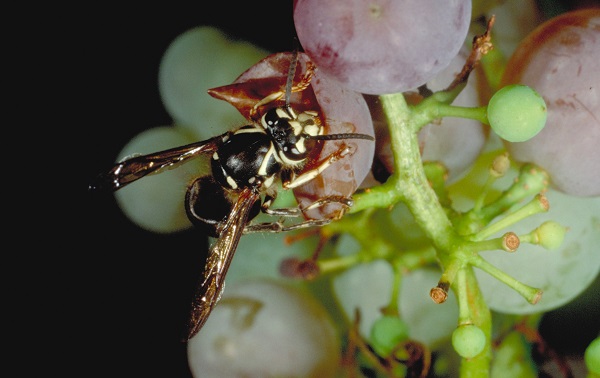Harvest Pests of Grapes
ENTFACT-225: Harvest Pests of Grapes | Download PDF
by Ric Bessin, Extension Specialist
University of Kentucky College of Agriculture
Honey bees, wasps, hornets and bumble bees can be common pests of grapes as they begin to ripen and they are a nuisance or worse to many pickers as they reach for the clusters.
These insect pests may not even be noticed for most of the season, then can begin to appear by the hundreds in the last few days leading to harvest. They are attracted to the high sugar content of the fruit that increases just before harvest. While many of these are considered beneficial insects during most of the season as some are pollinators and others predators of insect pests, at harvest they can become serious pests. While bothersome to all pickers, they can be life threatening to those that are hypersensitive to their stings.

Figure 1. Bumble bees feeding in grape cluster.
Bees, wasps and hornets are social insects that build nests and live in colonies. Depending on the species, there can be a few dozen to many thousand individuals in a colony and many of these colonies reach their peak population close to grape harvest. Workers that are lost for one reason or another are quickly replaced by other nest mates. In mid summer, these colonies are actively searching for sugary liquids while other nectar sources may be drying up.
Many grape growers would like to have an insecticide that could control these pests at harvest, but spraying to control bees, wasps and hornets at harvest has several limitations. First, killing a few workers does little good, as they are readily replaced by others from the nest. Second, the products that are effective against these pests have required pre-harvest intervals (REI's) that prohibit their use in the final few days before harvest.

Figure 2. Yellowjacket wasp on grapes.
Management
Bees, wasps and hornets are very opportunistic, in mid to late summer they are actively searching for sources of sugars. Once they find sources of sugary foods, they will aggressively forage in those areas and recruit additional workers from the colony.
For this reason, it is important to maintain good sanitation around the vineyard in the weeks leading up to harvest. This includes other types of produce that may attract these pests as well as trash receptacles. Empty soda and juice cans are highly attractive to foraging bees and wasps.
If bee, hornet or wasp nests are spotted during the season, they need to be eliminated prior to the harvest period. The closer they are to the vineyard, the greater the potential problem. Nests for these social insects can be located in the ground, trees, or outbuildings. Some growers have had limited success using yellowjacket traps to reduce the number of foraging workers. These traps do not eliminate the colonies, but may reduce the number of workers in an area if used for the entire season. These traps can be baited with tuna fish, cat food, or sugary liquids. The traps are clear with a funnel in the bottom that allows the workers to enter.

Figure 3. Baldfaced hornet feeding on grapes.
If bees, wasps or hornets are common in the vineyard at harvest, then hypersensitive pickers should wear gloves and/or head netting for protection.
Revised: 11/19
CAUTION! Pesticide recommendations in this publication are registered for use in Kentucky, USA ONLY! The use of some products may not be legal in your state or country. Please check with your local county agent or regulatory official before using any pesticide mentioned in this publication.
Of course, ALWAYS READ AND FOLLOW LABEL DIRECTIONS FOR SAFE USE OF ANY PESTICIDE!
Photos courtesy Ric Bessin, University of Kentucky Entomology
